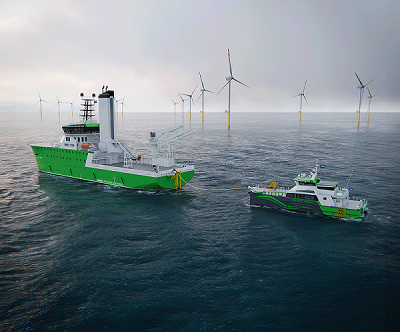Damen Shipyards Group has unveiled a cutting-edge offshore charging concept aimed at significantly reducing emissions during the active phase of offshore wind farms.

The groundbreaking system plans for a wholly electric crew transfer vessel (CTV) that can recharge at a turbine or a Damen’s commissioning service operations vessel (CSOV) equipped with a charger.
Although the infrastructure for turbine-mounted rechargers is not yet fully developed, vessel-to-vessel charging presents an immediate opportunity for CTV owners and operators to invest in the sustainable technology of the future, according to Mark Couwenberg, Product Manager Service Operations Vessels at Damen.
Couwenberg explains, “Offshore charging is crucial for a fully electric CTV operation. Traditionally, this would rely on charging infrastructure at offshore wind farms. However, as builders of both CTVs and CSOVs, we thought of including the charging scope within our own vessels. This can be implemented with a diesel-powered CSOV or a fully electric version. Though the fully electric version is preferable for reducing emissions, this solution allows CTV operators to invest today, readying for the wider distribution of fully electric CSOVs in the future.”
The challenge lies in installing an extensive battery system on board a CTV due to weight and space restrictions. By installing the system on the larger, less space-sensitive CSOV, the smaller vessel can access the energy it needs without sacrificing its capabilities.
Damen further notes that using the CSOV as a charging host offers additional benefits. The stern of the ship is lower than a turbine, providing easier access to the charger. Additionally, the CSOV can change its position, enabling the CTV to charge in the most protected position relative to wave conditions.
Damen’s charging system concept was developed in collaboration with UK-based MJR, an expert in offshore charging systems. The CTV would connect via a bell mouth that captures the charger lowered from a reel on the CSOV’s aft deck.
Once the personnel have disembarked, the vessel can connect using a highly automated, safe process. It is anticipated that charging could be completed in 2-3 hours, contingent on the operational profile.
Original Story at www.offshorewind.biz
